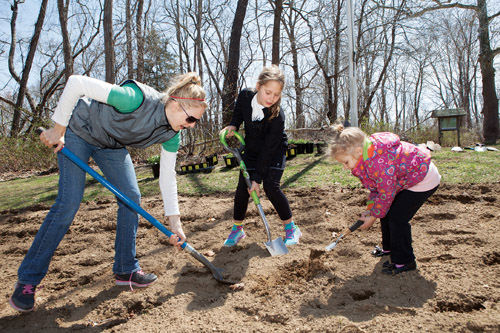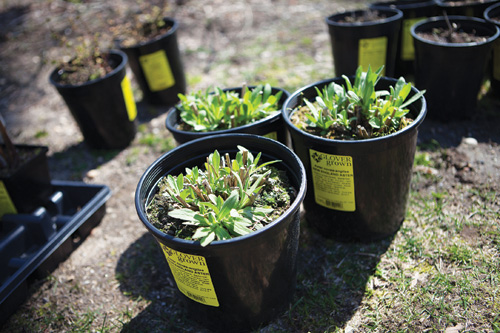Cleaning the bays with ‘conservation landscaping’

Build a rain garden, help the environment, get a reward.
It’s a simple as that.
The federal Peconic Estuary Program, which was created 20 years ago to improve water quality in the Peconics, will offer rewards of up to $500 to residents in Southold’s Hashamomuck Pond watershed area and the Reeves Bay watershed in Flanders who work to combat groundwater pollution by installing rain gardens, rain barrels or other forms of “conservation landscaping” on their properties.
This summer, the Peconic Estuary Program plans to install rain garden demonstration projects near Hashamomuck Pond and at one of the buildings at Big Duck Park in Flanders to draw attention to the program.
So, your first question is probably “What’s a rain garden?” And that’s likely followed by “What’s a rain barrel?”
The nonprofit environmental organization Group for the South Fork teamed up with local Girl Scouts Saturday to provide answers at Downs Farm Preserve in Cutchogue, on the grounds of the old Ford Corchaug Indian archeological sites.
“A rain garden is a very specific garden,” said Missy Weiss, an environmental educator for Group for the South Fork and program manager at the preserve. “It’s not something you would plant in your backyard if it’s a flat area,” Ms. Weiss said. “A rain garden would be used if you had a slight slope in your lawn, so that stormwater runoff naturally will flow into the ground and be filtered by a collection of native plants.”

Stormwater runoff is often cited as a major source of surface and groundwater pollution because it carries pollutants like fuel and animal waste from streets and into the water.
A rain garden serves two purposes, Ms. Weiss said. It waters the plants, of course, but the plants — if you choose the right types — will also filter out contaminants the water might have picked up, so it’s cleaner when it returns to the ground.
On Saturday, members of Girl Scout Troop 1971, Service Unit 60, in Cutchogue helped build a demonstration rain garden at the preserve, with the aim of not only demonstrating what one looks like but educating residents on other ways to protect the Peconic Estuary.
The rain garden the scouts created in Cutchogue is also connected to a rain barrel, which collects water from a roof gutter so it can be used again to water plants. Troop leader Tonya Witczak said she got to know Ms. Weiss when her daughter attended the “storytime” program Downs Farm Preserve runs for the Southold Mothers’ Club.
“We had so much fun and this place is beautiful, so I asked, ‘What else can my girls do?’ ” Ms. Witczak said. “Last year we did a huge planting over at Orient Beach State Park for Earth Day and now we’re doing this. The girls love to plant things, they love to get dirty and work in the dirt. We’ve been trying to do this project for some time now.”
On Saturday, the scouts planted ferns, asters, lowbush blueberries, native grasses, milkweed and other plants that will filter rainwater and return clean water to the ground.
“We try to use native plants, specifically as local as possible, that we know have been documented to have grown here on Long Island,” Ms. Weiss said. “If that’s not possible, we try to use as close a species to that as possible.”
The Group for the East End is monitoring will monitor the PEP rebate program to make sure people are doing it right, Ms. Weiss said.
The rebates will award different amounts for different conservation projects, up to a maximum of $500 per location. The program will operate on a first-come, first-served basis, according to education and outreach coordinator Jennifer Skilbred, and is supported by $50,000 in funding from the U.S. Environmental Protection Agency. To qualify for program rewards, rain gardens must be at least 50 square feet and rain barrels must hold at least 50 gallons.
It won’t take more than a day to build a rain garden, Ms. Weiss said, but participants might need to do some research beforehand. For instance, a depth of six to eight inches of available soil is needed to make sure the plants will remain stable, she said.
While rain gardens can help prevent pesticides or fertilizers from being carried into the groundwater, Group for the East End isn’t promoting their use as a justification for continued of pesticides or fertilizers, Ms. Weiss said. They would rather homeowners didn’t use those products on their lawns in the first place.
For more information visit PeconicEstuaryProgram.com or email [email protected].







